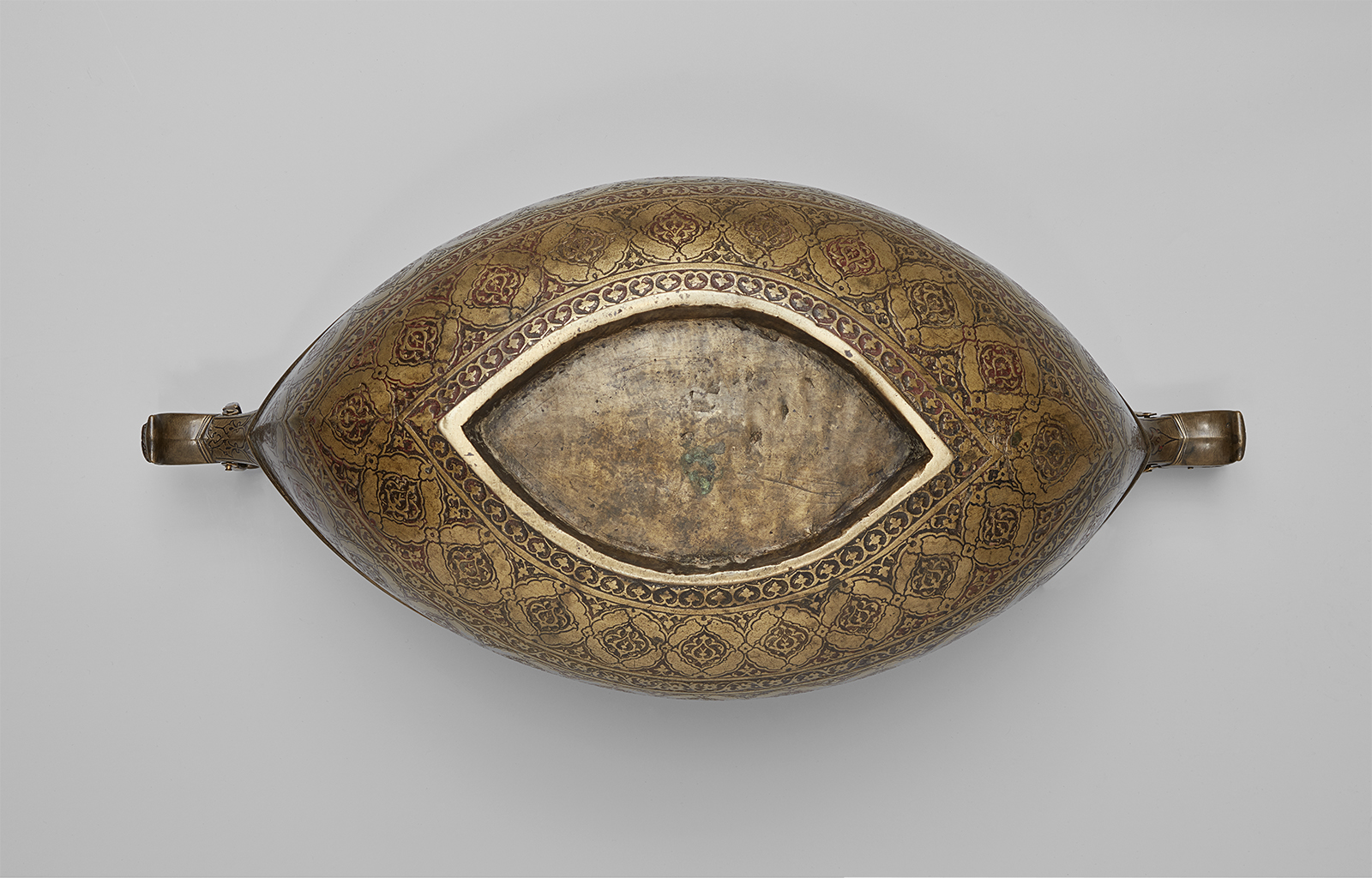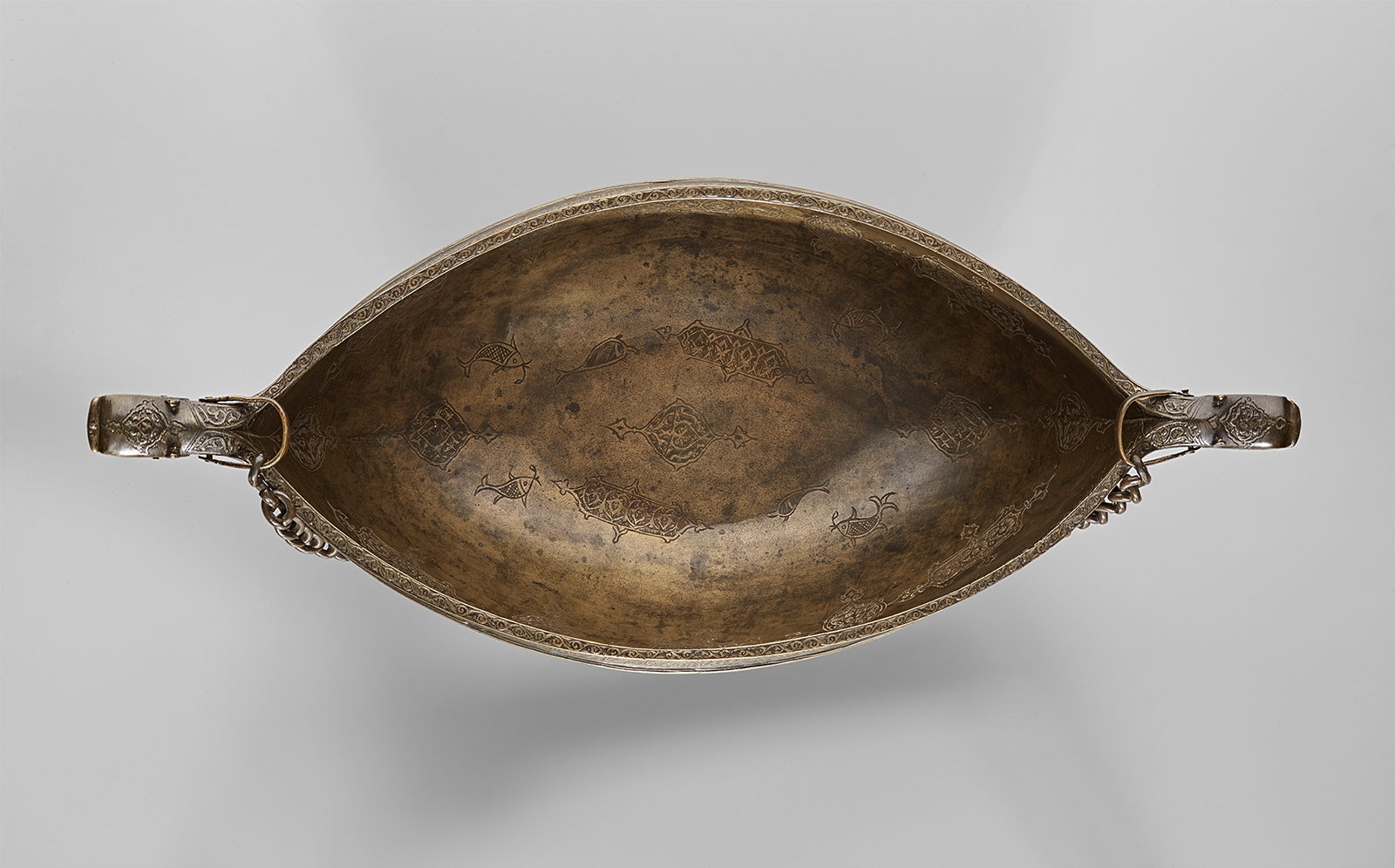Click on the image to zoom
Kashkul (Begging bowl)
- Accession Number:AKM612
- Place:Iran
- Dimensions:61 cm
- Date:late 16th century
- Materials and Technique:brass
Kashkuls, or begging bowls, were carried by Sufi Muslim mystics in order to collect alms.[1] Made of a variety of media, including metal, wood, and coco-de-mer shells, kashkuls also served as food or drinking containers. Their crescent-moon shape, which stems from Iranian wine-vessels fashioned like boats, symbolizes the emptying of the Sufi mystic’s ego and the renunciation of worldly possessions.[2]
Further Reading
Fierce dragon heads adorn the ends of this vessel; alternating bands of floral medallions and vegetal motifs have been engraved across its rounded body. Geometric motifs are also etched into the bowl’s interior, further embellishing its surface. A chain hangs between the kashkul’s two extremities, allowing it to be carried by hand or around the neck.
A Persian poetic inscription runs along the upper rim:
The prince of the two worlds, the seal of messengers
Came last: he became the pride of the very first
To the throne and the seat, not to the sky, he made his ascent
The prophets and the friends of God were in need of him
His existence was spent in guarding the two worlds
The whole surface of the earth became his mosque
The lord of the two worlds, the leader of mankind
The moon was split by the tip of his finger.[3]
This poetic excerpt celebrates the Prophet Muhammad, “the prince of two worlds” and the “seal of messengers,” as well as two of his major miracles. The first is his ascension to the heavens, or mi‘raj, a major motif in Sufi spiritual thought, which is alluded to in the poem by the mention of the Prophet’s ascent to “the throne and the seat.”
The second allusion to Muhammad’s miracles is a reference to the the Prophet’s splitting of the moon in half (shaqq al-qamar).[4] In Sura 54 of the Qur’an, this event is described as both an omen of the apocalypse and a confirmation of Muhammad’s prophecy, as the splitting of the moon occured publicly, in contrast to the Prophet’s ascension.[5] Indeed, Muhammad’s cleaving of the moon was witnessed by the whole world, symbolizing his power over nature and cementing the importance of the moon in Islamic religious thought.[6]
The reference to the crescent moon in the verses engraved on this kashkul may call attention not only to the object’s curved shape, but also to earlier literary references. In the 13th century, the image of the kashkul as a crescent moon becomes more prominent as wine is often described in Persian Sufi poetry as the liquid light of the late-evening sun.[7] While such metaphors referred to the liquid contents of a kashkul, many other kashkuls—such as examples held in the collections of the Victoria and Albert Museum[8] in London and in the Metropolitan Museum of Art[9] in New York—featured Qur’anic excerpts. These inscriptions included invocations to prominent religious figures, such as ‘Ali and Hussain.
As the symbol for the Sufi mystic’s quest for the divine, the boat-shaped kashkul also symbolized the journey through the ocean of mystical knowledge. The aquatic metaphor is apt, as kashkuls were often carved out of shells of the coco-de-mer palm, which could be found on the shores of the Indian Ocean in Iran.[10]
However, very few kashkuls in use would have been as elaborately carved as this example in the Aga Khan Museum Collection or its aforementioned counterparts. Their embellished surfaces and costly materials would have stood in stark opposition to the mystic’s endeavour to embrace humility through his commitment to a religious life.[11]
— Michelle al-Ferzly
Notes
[1] Akbarnia, Light of the Sufis, 26.
[2] Frembgen, “The Symbolism of the Boat in Sufi and Shi‘a Imagery of Pakistan and Iran,” 91; Khosronejad and Zarcone, “The Persian Dervish in Sufi Art and Material Culture,” 137.
[3] Melikian-Chirvani, “From the Royal Boat to the Beggar’s Bowl,” 35–6.
[4] Rodinson, La lune: mythes et rites, 165–6. For an illustration of Muhammad’s cleaving of the moon, see Gruber, The Moon, 106–7.
[5] Gruber, The Moon, 94–5.
[6] Gruber, The Moon, 18.
[7] Melikian-Chirvani, “La kashkūl safavide,” 171.
[8] See Victoria & Albert Museum, 876-1889, http://collections.vam.ac.uk/item/O53738/kashkul-unknown/.
[9] See Metropolitan Museum of Art, 09.202.2, https://www.metmuseum.org/art/collection/search/445960.
[10] Ekhtiar, Masterpieces from the Department of Islamic in the Metropolitan Museum of Art, 242.
[11] Ibid.
References
Akbarnia, Ladan, and Francesca Leoni. Light of the Sufis: The Mystical Arts of Islam. Houston: The Museum of Fine Arts; New Haven and London: Yale University Press, 2010. ISBN: 9780300164640
Ekhtiar, Maryam, ed. Masterpieces from the Department of Islamic in the Metropolitan Museum of Art. New York: Metropolitan Museum of Art; New Haven: Yale University Press, 2012. ISBN: 9781588394347
Frembgen, Jürgen W. Kleidung und Ausrustung islamischer Gottsucher: Ein Beitrag zur materiellen Kultur des Derwischwesens. Weisbaden: Harrossowitz Verlag, 1999. ISBN: 9783447041843
Gruber, Christiane, ed. The Moon: A Voyage Through Time. Toronto, ON: Aga Khan Museum, 2019. ISBN: 9781926473154
Khosronejad, Pedram, and Thierry Zarcone. “Visual Representations of the Persian Dervish in Sufi Art and Material Culture: Preliminary Report from the Bunyad Institute, Tehran, Iran (part 1).” Anthropology of the Contemporary Middle East and Central Eurasia 2.2 (2014/2015): 193–215.
Melikian-Chirvani, A.S. From the Royal Boat to the Beggar’s Bowl. New York: Islamic Art Foundation, 1992. ISBN: 9780199215010
---. “Le kashkūl safavide, vaisseau à vin de l'initiation mystique.” In Études safavides, ed. Jean Calmard. Paris and Tehran: Institut Français de Recherche en Iran, 1993 (Bibliothèque Iranienne, 39), 165–94. ISBN: 9782909961026
Rodinson, Maxime. “La lune chez les arabes et dans l’Islam.” In La lune: mythes et rites, ed. Philippe Derchain. Paris: Editions du Seuil, 1962, 151–215. ISBN: 9782020027762
Note: This online resource is reviewed and updated on an ongoing basis. We are committed to improving this information and will revise and update knowledge about this object as it becomes available.






